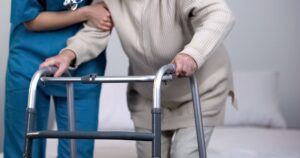If you’re preparing for or recovering from a hip replacement, you’re not alone. In 2023, over 58,500 Australians—many of them older adults—undergo this life-changing surgery each year. Whether due to arthritis, injury, or years of wear and tear, hip replacement surgery can offer a new lease on life by relieving pain and restoring mobility.
However, at Home Care Assistance, we know that this can be a scary time. Understanding what happens after surgery can help reduce this fear. So, what should you expect in the following days, weeks, and months? Recovery doesn’t happen overnight, but you can confidently navigate the road to healing with the correct information and support.
Here’s a practical, down-to-earth guide on what to expect after a hip replacement.
The First Few Days in Hospital
Most people spend 3–5 days in hospital after their hip replacement, though some go home sooner depending on their health and the hospital’s recovery program. The length of time you spend in the hospital will depend on your surgery, general health, and how quickly you recover from the effects of the surgery.
While in hospital:
- Pain will be managed with medication. Let your care team know if you are in pain or experiencing any side effects from the medication.
- You’ll start moving quickly—usually within a day of surgery. A physiotherapist will help you sit up, stand, and take your first steps, often with a frame or crutches.
- You’ll learn how to protect your new hip, including how to sit, stand, and lie down safely. Specific movements (like bending too far or crossing your legs) may be off-limits initially. It is important to take note of the information on what you should and should not do, as this will help your recovery. You should be provided with written information.
Many hospitals in Australia now use Enhanced Recovery Programs, which aim to get you moving earlier and heading home sooner—with the proper support in place.
Heading Home: Setting Up for Success
Before going home, it’s important to prepare your space for safety and comfort:
- Remove trip hazards like rugs or cords.
- Install grab rails in the bathroom and near the stairs if needed.
- Use a raised toilet seat or chair to avoid bending too far at the hip.
- Arrange help with meals, shopping, and housework for at least a couple of weeks.
If your surgery is pre-planned, you can arrange this before going to the hospital. If your surgery results from a fall or accident and is unexpected, you might need the help of family to prepare your home or ask the hospital to see what services are available to assist with this.
Sometimes, your doctor may recommend a short stay in a rehabilitation centre to support your recovery before you return home.
If you’re eligible, My Aged Care services or your private health insurer may assist with home modifications, equipment hire, or in-home support. Consider engaging support at home from a home care provider such as Home Care Assistance to provide extra care upon your return home. This can be arranged temporarily to help you through the transition period while you recover at home and make it safer for you to return home sooner.
Managing Pain and Medication at Home
Pain after surgery is normal—but it should gradually improve over time. Your doctor will prescribe pain relief, which might include tablets or anti-inflammatory medication. Always follow the instructions carefully and inform your GP if you experience side effects.
If you have trouble remembering when to take medications, try setting a timer or alarm. Also, write down when you take medications to help you stay on schedule.
You may also be on blood-thinning medication for a while to reduce the risk of blood clots. Staying active and exercising helps with circulation and recovery.
Getting Moving Again: The Role of Physiotherapy
Rehabilitation is a big part of your recovery. You’ll likely have a set of exercises to do at home, and many people also attend outpatient physiotherapy or work with a home visit physio.
The goal is to:
- Regain strength and flexibility in the hip
- Improve balance and confidence when walking
- Get back to daily activities like dressing, cooking, or walking the dog
You’ll usually start using a walker or crutches, then transition to a walking stick, and eventually walk unassisted. For most people, this happens over a period of 6–12 weeks. However, everyone’s recovery is different, so be guided by your health professionals.
It’s normal to feel tired or stiff for a while. Be patient with yourself and celebrate small milestones.
When Can I…? Common Recovery Questions
Drive again: Most people can drive after 6 weeks once they can move freely and aren’t taking strong pain medication. Your surgeon will advise when it’s safe.
Return to hobbies: Gentle activities like gardening, walking, or swimming (once wounds are healed) are encouraged. High-impact sports are usually discouraged but talk to your doctor about what’s appropriate for you.
Sleep comfortably: For the first six weeks, you may need to sleep on your back or non-operated side. Using a pillow between your legs can help.
Watching for Warning Signs
While complications are rare, it’s important to know what to look out for:
- Increased pain or swelling in the leg
- Redness or heat around the wound
- Fluid leaking from the wound
- Fever or chills
- Sudden chest pain or shortness of breath
If you notice these symptoms, contact your doctor immediately or go to your nearest emergency department. If in doubt, it is better to get checked out. Don’t wait to see if things get worse; get it checked early if something does not seem right.
Keep Connected
Recovery from a surgery such as a hip replacement can be isolating. It is common to experience some feelings of isolation and frustration. If you are not feeling up to going out, invite a friend over for a cup of tea or a game of Scrabble. Tell them about your surgery, and don’t be afraid to let them know if you are tired and have had enough.
Looking Ahead: Life with Your New Hip
Most people report a significant improvement in pain, mobility, and quality of life after a hip replacement. It can take 3–6 months for some to feel fully recovered and up to a year for others to feel completely back to normal.
Your new hip is designed to last for many years—often 15–20 or more—especially if you maintain a healthy lifestyle, stay active, and avoid high-impact activities that may wear out.
Due to pain, many seniors return to travel, socialising, and hobbies they had previously put on hold. It’s a chance to regain independence and enjoy life with less discomfort.
A hip replacement is a big step—but it can be the beginning of a brighter, more mobile future. Recovery takes time, patience, and a bit of support—but you’re not alone. Lean on your care team, ask questions, and give yourself the grace to heal at your own pace.
Support at home from a specialist provider, such as Home Care Assistance, can bring enormous benefits and comfort to your quality of life while living independently. Home Care Assistance has viable solutions for independent living. For more information, get in touch with a Home Care Assistance near me today.
As a leading age care provider, Home Care Assistance offers tailored in-home care services for older Australians, enabling them to live happier and healthier lives in the comfort of their own homes.
We offer private and government subsidised Care Packages and have office locations that are a registered NDIS provider. Our Care Workers undergo extensive training in order to deliver unmatched in-home aged care services where people can continue ageing in place. We are proud ambassadors of the My Aged Care government funded aged care program, enabling Australians to successfully navigate the process and gain approval for in-home care support packages. Home Care Assistance offers hourly care, specialised care, Alzheimer’s and Dementia care, hospital to home care, and 24 hour in home care.













